Viafoura, the online community engagement platform, and Poool, The Membership and Subscription Suite, an audience conversion, management & retention platform to turn content into business have released an exclusive white paper, the key points of which we summarize below. The white paper is available free of charge here.
TLDR: - Engagement elements, such as commenting, as well as soft conversion steps like newsletter sign-up and registration are essential for publishers to move anonymous visitors through the funnel towards subscription - Registration can, however, also be incredibly valuable for revenue diversification given that desanonymization allows for targeted advertising spots - For this audience-focused approach to be a success, you should place ARPU as your north star KPI
First, note that moving readers through the conversion funnel increases ARPU. Why? Because, at each stage of the funnel, we see the metrics that drive monetization increase:
- Page Views (PVs)
- RFV engagement metrics: Recency, Frequency, Page Volume.
The graph below shows the key stages of engagement according to user status, revenue generated by each… and audience size.

1. From anonymous to registered
When looking to drive up the average revenue per user (ARPU), the first step is to move the reader from Anonymous through to Registered. This is a fairly large leap, especially given that up to 90% of your audience only visit once a month (Poool data).
What can you do to make this step more accessible?
A) First, engage with your anonymous audience so that they're ready to register
Engaged members are users that, although remaining anonymous, are now interacting with engagement elements across the site, spending more time on site and becoming increasingly more loyal to your brand. Viafoura data suggests that readers who interact with your engagement features are 51x times more likely to register than an unengaged user (Viafoura data).
How do you engage this audience? Make your community discoverable.
Place discoverability elements in areas that readers are familiar with:
- Integrate comment counts into the byline of the article header on both homepage topic pages and article pages
- Add a sharebar onto the sides of articles
- Add a mid-article unit to draw attention to your community, highlighting community opinions and sparking curiosity through polls
- Consider a notification bell in the top right corner of the sticky header to alert readers of a new comment or article
💡Top tip to make the most of your notification bell:
- For push notifications, preload at least one notification onto the bell to increase engagement from the moment a user arrives onsite. Large Canadian publishers saw a 30% lift in active conversations attributed directly to the bell.
- Use the notification bell to drive users to a live event such as an “Ask-Me-Anything (AMA)”
B) Second, use a dynamic registration wall to adapt your strategy to your users
Publishers can present dynamic registration walls that are adapted to an anonymous user's behavior, factoring in their average dwell time and their Recency, Frequency and Volume (RFV) score.

So, even without knowing the users, just understanding the reader's behavior onsite and having their time in comments as a factor in that propensity score can significantly drive registrations.
Case study example: ELLE Magazine
When launching their digital subscription strategy, ELLE Magazine chose to increase engagement through a registration wall, offered as a first step in the conversion journey prior to the paywall.
This model not only reduced the risks of launching a premium model but also allowed for first-party data collection, targeted advertising and increased subscriber conversion rates by 10x.

2. From registered to subscribed
A) Increasing propensity to subscribe
At the point of registration the user has a custom reader ID, and any data collected prior to this point now becomes tied and identified to the single user. This gives you a hugely valuable opportunity to personalize the user experience, and build dynamic journeys based on their profile or context. However, it's also essential to ensure that these members remain engaged so that they will continue to increase in propensity to subscribe.
How do you achieve this? Ask users to provide user generated content (UGC).
UGC contributors are critical to driving subscriptions, revenue, and retention. One way to drive your registered users to create UGC is to use the notification bell, letting a commenter know when other users are interacting with their content, when new content is published, when their own UGC has been featured in an “Engagement Starter” unit (mid-article unit) or when they have received a badge.
B) Increasing readers' ARPU with targeted ads
De-anonymization supports both advertising and subscription revenue streams. Thanks to the first-party data collected during registration, publishers can sell advertising spots at a higher cost, whilst simultaneously presenting users with ads that are more suited to their interests. Trade Desk, for instance, found the following ad revenue increase (CPM) that a publisher can expect with first-party data.

Conclusion: placing ARPU as your north star KPI
Subscription is the end goal. However, a great deal of work is required prior to the paywall to increase profitability of non-subscribers as well as their propensity to subscribe in the future. Registered users are indeed far more likely to become a subscriber. For instance, at The Independent, registered users are 45 times more likely to subscribe.
Collecting first-party data through declarative data, offered at the point of registration, as well as engagement, interest, and sentiment data at every point of the user's online journey (progressive profiling), enables publishers to build engaged and thriving online communities.
We'd therefore recommend placing ARPU as your north star KPI, ensuring all teams are aligned and working collaboratively to move users through the value stages of the funnel towards newsletter sign up, registration, subscription and beyond.


